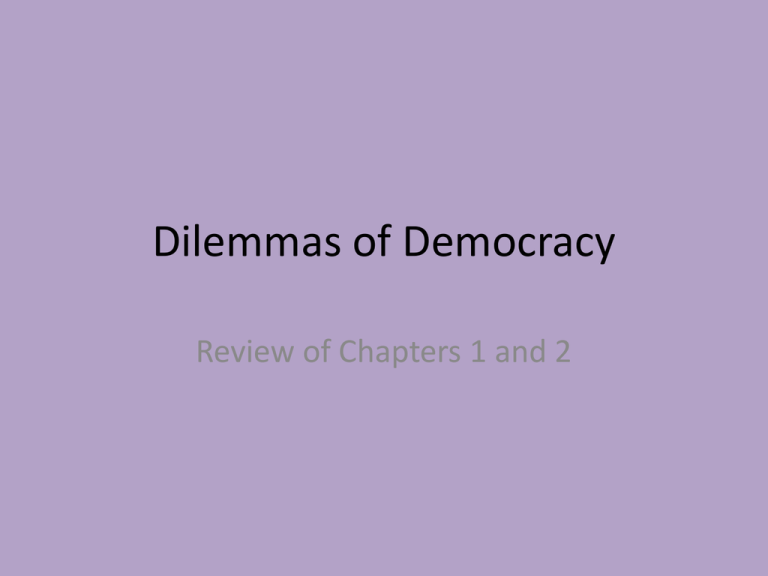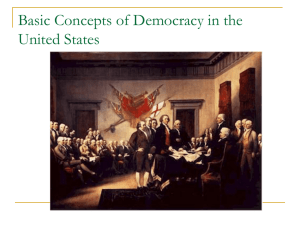File
advertisement

Dilemmas of Democracy Review of Chapters 1 and 2 What should government do??? What should government not do??? Chapter 1 • What is government? Book definition v. yours • Due to globalization our definition of government has changed. • 3 main purposes of government – Maintain order – Provide Public goods – Promoting equality Chapter 1 Thomas Hobbes http://oregonstate.edu/instruct/phl 302/texts/hobbes/leviathancontents.html John Locke http://www.thisnation.com/library/books/lock e/2ndtreatise.html Chapter 1 • Freedom, Order, Equality – Freedom: of and from – Order: basic, social order, police order – Equality: Political, Social (equality of opportunity and equality of outcome) Dilemmas of government • Original dilemma: How much freedom should be sacrificed for order? (Hobbes and Locke) • Modern dilemma: How much freedom should be sacrificed for equality? (20th century) – Very controversial and dependant on political ideology • How have we seen these conflicts today? Chapter 1 • Popular Culture examples on how still issues today? – Freedom • http://www.poemhunter.com/song/freedom-2/ – Order • Rap music – Equality • Rage against the machine Chapter 1 Ideology v. Scope Chapter 1 American Ideologies Chapter 1 Liberals • Want generous government support of social programs • Support government activism but oppose government regulation of abortion • Are more tolerant of alternative lifestyles and would use coercive power to support equality Conservatives • Want smaller government budgets and fewer government programs • Oppose government activism but support government control of sexually explicit material • Want government coercive power to maintain social order Chapter 1 • HW: What ideology are you?? • http://www.theadvocates.org/quiz • BE PREPARED TO DISCUSS! Chapter 2 • Theories of a democratic government include consideration of: – Autocracy: power to govern is concentrated in the hands of one individual. – Oligarchy: power is concentrated in the hands of a few people. – Democracy: in theory, the people rule, either directly or indirectly. Chapter 2 • Lets focus on democracy!! What is it really?? – Americans believe “the people” should rule • Who are the people? – Demos “people”, kratos “power” • But what is it?? Chapter 2 Procedural- “how the people govern” this is the focus! The procedures to make policy • • • • Universal participation Political equality Majority rule Responsiveness Substantive- “what the govt actually does” --> the substance of the policies • Must guarantee civil rights and liberties • Social and economic rights Procedural is clear, but does not guarantee minority rights Substantive is unclear on how to guarantee democracy by focusing on minority rights BASICALLY WE HAVE A PROCEDURAL FOCUS, WHILE INSTITUTING SMALL SUBSTANTIVE VIEWS Chapter 2 Participatory (direct) • Still practiced in smaller communities • Too large and complex of a society= need a full- time professional government • Impractical due to low levels of citizen participation Representative (indirect) • Framers felt that direct was undesirable (come back to this next unit) • Elected officials are expected to represent voter views/interests • RESPONSIVENESS : leads officials to pay attention to public opinion to achieve majority rule Chapter 2 • Just because we elect officials does not guarantee democracy • Institutional mechanisms are what allow public opinion to be translated into government policies (we will talk more about this in later chapters) – Elections – Political parties – Legislatures – Interest groups Chapter 2 • So… the Procedural view of democracy is the most understood and accepted lets break down these into how government incorporates these principles 1. 2. 3. 4. Who participates? POPULAR SOVEREIGNTY How much participation? POLITICAL EQUALITY What rule is used to make decisions? MAJORITY Since we practice rep dem, how do we make sure democracy (1-3) is achieved? RESPONSIVENESS Chapter 2 • Government incorporates all 4 of these principles into two alternative models of democracy – Majoritarian: favors unlimited implementation of the 4 procedural values to attain true democracy – Pluralism: favors limited government implementation of the values – Elite: favors oligarchy (not really used, but many believe this is the model US democracy takes) Chapter 2 • Strengths and weaknesses of Majoritarian and Pluralism models? • Of the two models, which seems to approximate the type of democracy the US practices? • Why is it hard for other nations to democratize today? All of these ideas are important in your consideration of American government.





